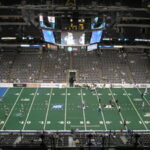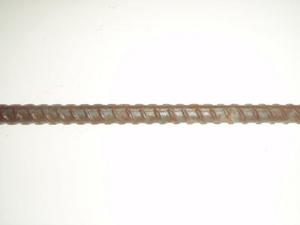Draft – Comments Welcome
Outline
- Minimum Reinforcement
- Maximum Reinforcement
- Development Length
- Embedment of V.S. into Footing
- Termination of V.S. at Top of Wall
- Reinforcement Splices and Continuity
- Summary
- References
1. Minimum Reinforcement
The minimum vertical reinforcement ratio for a wall in general is 0.0012 (Gr. 60 bars not larger than #5); however, this is for a wall acting as a compression member. For flexure the minimum reinforcement is …
… (3 √f ‘c / fy ) b d … but not less than 200 b d / fy
for our case,
… 3 √f ‘c is 3 √3000 = 164 … so the 200 governs, giving us …
… 200 (psi) b d / 60,000 psi = 0.0033 b d.
Since our final design ended in 0.0044 … we’re good.
The horizontal steel satisfies the minimum amount for walls already, and we are not counting on it for flexure (even though we know there will be some two-way action), so, we’re good in the horizontal direction.
2. Maximum Reinforcement
Our wall is acting primarily as a flexural member (retaining the backfill soil). Hence, the maximum limit on the reinforcement should be such that the strain in the steel will be at least 0.004 when we reach the flexural strength of the wall. This will be ensured with a reinforcement ratio of not greater than 0.0155 for 3000 psi concrete and 60,000 psi steel (based on effective depth d).
Our reinforcement ratio is 0.0044 (also based on d), so, good!
The minimum strain of 0.004 in the steel in a flexural member will produce ductile behavior during failure. Whether the 0.004 strain limit is really applicable to a retaining wall below grade could be argued, but since we meet the limit anyway, it’s not worth arguing.
3. Development Length
We must make sure that there is sufficient contact area between concrete and reinforcement to be able to utilize the reinforcement; this is accomplished by specifying a certain `length’ of contact (development length, ld ).
From the ACI Code, Section 12.2.3,
ld = { (3/40) (fy /√f ‘c) (α β γ λ ) / [ (c + kt r) / db ] } db
We will cover development length in greater detail in another lesson. For our particular situation at hand we will use α = 1.3 for the horizontal reinforcement (more than 12 in. or fresh concrete cast below) and 1.0 for the vertical reinforcement; β = 1.0; γ = 0.8; λ = 1.0; c = 1-13/16 in. (smaller of the distance of bar center to face of concrete or half the bar c.t.c spacing), and k t r = 0.
The ratio (c + kt r) / db in this example becomes 2.9 (using # 5 bars) but cannot be taken to be greater than 2.5, so,
ld = { (3/40) (60,000 psi /√3000 psi) (1.0 or 1.3)(0.8) / [ 2.5 ] } db
… = 26.3 db or 34.2 db …(depending on the `location’). (Sometimes development lengths are specfied in `diameters’ … in this case, say, 26 and 34.)
Thus, for the # 5 horizontal reinforcement … ld = 21.4 in. (use 22 in.),
and for the vertical reinforcement … 16.4 in.
The code allows us to reduce our development length in proportion to our `excess’ reinforcement provided. We found earlier that our ratio of (vertical) reinforcement needed to that provided is 0.81, so, we could reduce the development length to 0.81 x 16.4 = 13.3 in. I’m going just leave it at 16 in. (16.0).
So, summarizing,
Development lengths are (# 5 bar): 16 in. for the V.S. and 22 in. for the H.S.
Development lengths as is may not mean much to the Contractor (say, in Construction Documents), but we’re not done yet!
Note that we have not `tackled’ the footing. But let’s say in this example that it is to be reinforced with # 5 longitudinal bars (also Gr. 60) and no transverse bars are required. Further, let’s assume that the longitudinal footing reinforcement will be cast with less than 12 in. of fresh concrete below. (You’ll see where this is leading a bit later.)
But, now, we will check to make sure the bars (vertical tension reinforcement) are `developed’. The maximum bending moment occurs 4.8 ft from the top of the wall. To develop the reinforcement it must extend at least the development length in both directions from where it is needed. Since the bars will extend over 4 ft upward and at least 3 ft downward, we are good!
But, there are a few more things we need to check: where the reinforcement `ends’ at the top and bottom of the wall.
As we go away from the point of maximum moment the amount of length available for development decreases faster than the need for it, so we better make sure we don’t get to a place where it is needed more than it is available and thus tend to pull the rebar out. This could potentially occur at the ends of the `simply supported’ beam. Making sure this doesn’t happen is accomplished by satisfying Equation (12-3) of the ACI Code (Section 12.11.3). I call it the `pullout calc’.
Equation (12-3) is … (slightly re-written)
… ld ≤ (1.0 or 1.3) Mn / Vu + l a … (ACI 12-3)
where,
Mn = nominal moment strength assuming all steel developed to fy,
Vu = factored shear at the section,
l a = the embedment of the rebar past the centerline of the support, and,
where the 1.3 represents an increase of 30% allowed if the reinforcement being developed is confined by a compressive reaction; otherwise use 1.0.
4. Embedment of V.S. Into Footing
Section 12.11.3 provides that Eq. 12-3 need not be satisfied if the reinforcement terminates beyond the centerline of the support with a standard hook. In this regard we will `use’ the 4 in. basement slab as the `support’ at the bottom of the wall and require that the reinforcement be embedded into the footing with a standard hook. The minimum hooked bar development length is 8 diameters (in our case 5 in.) or 6 in. (whichever is larger); so,
… V.S.: … embed 6 in. into footing with standard (90º) hook.
NOTE: for the basement slab to provide lateral support for the wall, the slab concrete must be poured against the concrete core of the wall. This will require removal of bottom 4 in. (or so) of ICF on the inside after the wall has become hard.
5. Termination of V.S. at Wall Top
In the absence (as I see it) of clear provisions as to handle the detailing of the vertical reinforcement at the top of the wall (being that it is supported laterally by a wood framing system), I provide the following:
Add a # 5 horizontal bar to the top 12 in. of the wall and `consider’ the top 12 in. of the wall as a `grade beam’ support.
Terminate the V.S 3 in. from the top of the wall. The `centerline’ of the support is thus 6 in. from the top and l a is thus 3 in.
With regard to ACI Equation 12-3,
from Part 1, … φ Mn = 52,800 lb-in., and V top = 694 lb.
So,
Mn= 52,800 lb-in. / 0.9 = 58,600 lb-in., … and Vu = 1.6 (694 lb) = 1110 lb.
And, so, Eq. 12-3 …
Is ld ≤ (1.0) Mn / Vu + la ???…
Is 16 in. ≤ 58,600 lb-in. /1110 lb. + 3 in. = 53 in. + 3 in. = 56 in.???
Yes, way yes; pullout shouldn’t be a problem.
… Terminate V.S. 3 in. from top of wall.
6. Reinforcement Splices and Continuity
We will detail the V.S to splice at the footing-wall interface with standard hooks in the footing. Thus the hooks may be cast in place during footing construction with the remaining `straight’ V.S bars placed later during the wall construction. All of the reinforcement will be spliced at this location, hence, we’ll use a Class B splice. However, since we are at the end of a simple support condition, there is theoretically no demand on the reinforcement, thus I will argue the minimum development length of 12 in. and thus a Class B splice length of 1.3 (12 in.) = 15.6 in. (use 16 in.). So, … V.S lap splices 16 in. (splice at bottom of wall only). Practically this will be accommodated using 16 + 6 = 22 in. long (standard) hooked bars embedded in the footing 6 in. and protruding 16 in. (min.) above the footing. The straight wall pieces of rebar (installed after the footing) will thus go clear to the bottom of the wall (top of footing) and lap with the longer vertical legs of the hooks.
For the horizontal reinforcement we will allow Class B splices, for which the splice length is 1.3 ld = 21.4 in. = 27.8 in. (use 28 in.).
For the longitudinal reinforcement in the footing we could use the bar location factor of 1.0 resulting in a lap splice length (Class B) of 27.8 / 1.3 = 21.4 in. (use 22 in.). Good detailing involves being clear, and `economical’, but also recognizes that too much information (or options) may lead to confusion. Hence, it may be prudent to simply specify a single horizontal rebar splice length (28 in.). (And, in some cases, a single splice length may be prudent for both horizontal and vertical splices.)
For integrity of the entire foundation, the horizontal and longitudinal reinforcement should be continuous around the entire foundation (laps notwithstanding).
7. Summary
Now we are ready to summarize the design of the basement retaining wall.
Concrete 28-Day Compressive Strength: 3000 psi;
Reinforcement: Grade 60 ksi, Deformed;
Max wall height: 8′-4″;
Wall Core Thickness: 6-1/4 in. min.;
V.S.: # 5 @ 16 in. o.c centered 1-13/16 in. from the inside face (inboard tab of ICF); terminate V.S. 3 in. from top of wall; embed V.S. 6 in. into footing with standard hooks; V.S may be spliced at bottom of wall (16 in. min. splice length);
H.S.: # 5 @ 16-3/4 in. o.c., continuous, lap splice length 28 in.; provide 2 # 5 bars within the top 12 in. of the wall.
Note that some of this information might be located on a `General Specifications’ page, while other information might be detailed by dimensions, and other noted by text. Often I place splicing information with the `General’ requirements. The exact `locations’ of the two H.S bars in the top would probably be somewhat dictated by the specific `tabs’ of the ICF system.
8. References
Building Code Requirements for Structural Concrete, ACI 318, American Concrete Institute, P.O. Box 9094, Farmington hills, Michigan, 48333.
International Building Code, International Code Council, 4051 West Flossmoor Road, Country Club Hills, IL 60478.



